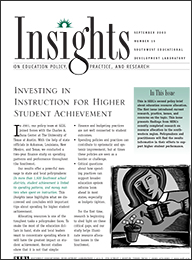About the Study - Examination of Resource Allocation in Education: Connecting Spending to Student Performance
Examination of Resource Allocation in Education: Connecting Spending to Student Performance
We studied fiscal and staffing allocation patterns in 1,504 independent districts in four states (Arkansas, Louisiana, New Mexico, and Texas). Ranking districts based on state achievement test scores gave us three levels of performance for each state. The top third of districts were called high performing and the bottom third termed low performing.
Five years of fiscal, staffing, and demographic data from the federal Common Core of Data (CCD) and the Census Bureau went into our study, along with three years of student performance data from each state department of education. For our analysis of spending and staffing patterns, we reviewed data on
- operating expenditures by function.
- teacher and administrator staffing.
- various district and student characteristics (district size, enrollment by race/ethnicity, percent of special education, and economically disadvantaged students).
- student achievement test scores.
We also studied spending in districts with consistent increases in student performance over time and called them improvement districts. We took a look at 12 improvement districts serving mostly minority and/or economically disadvantaged students to determine the practices and strategies they use to make spending and staffing decisions. We chose three districts in each state for this more in-depth look: one with an enrollment of 800–1,999 students, a second with 2,000–10,000 students, and a third with more than 10,000 students.
Using a variety of analysis tools and the wide array of data collected, we answered four research questions:
- What are the expenditure patterns over time in school districts across varying levels of student performance?
- How do improvement districts allocate their financial and human resources?
- What allocation practices have improvement districts implemented that they identify as effective?
- What barriers and challenges have improvement districts faced in allocation practices?
For a copy of the full research report, go to http://www.sedl.org/pubs/catalog/items/policy89.html.
Next Page: Southwestern spending practices mirror national trends

